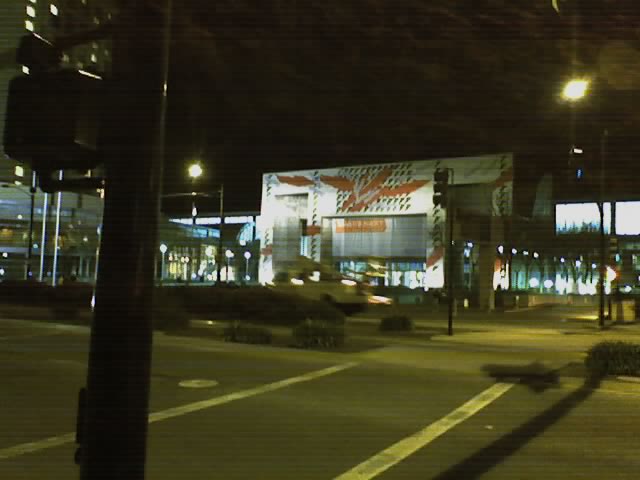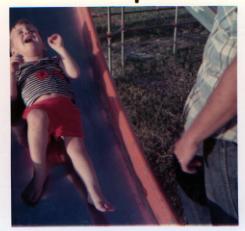I just got back. This year’s walk was fun and cool…bright and sunny, moving through the blocked-off streets downtown.
The band played a Pogues cover, which rocked.
I think the event continues for a while, if you’re interested (and in Austin).
Safe Place Walk
A random pug in a stroller…
Author Archives: Harvey
Two Political Articles
Reposting here, since my bulletins got buried under an avalanche of insanity.
This first article blows my mind. The perspectives of historians are interesting, focusing on analysis of presidential successes and failures (on the left and right). It’s long, but mind blowing; much of this you probably know, but seeing it together, organized as the criteria against which leaders are judged, is amazing.
Truthout Article
This second link is a book review, but it sounds fascinating:
Salon Book Review
GDC ’06
Today is the last day of the ’06 Game Developers’ Conference.
Three images from last night: The front entrace to the show, the sign on the civic auditorium, and the door to auditorium. The auditorium is where the Game Developers’ Choice awards are given out each year. This year Guitar Hero and Shadow of the Collossus both won awards. (Great games.) This is also where Deus Ex won some stuff, so the place is emotionally significant for me personally.



Game industry claws its way up.
Very surreal. (Peacebomb.)
The New York Times
March 24, 2006
by Daniel Terdiman
Game designers aim for Nobel Peace Prize
SAN JOSE, Calif.–Winning a Nobel Peace Prize may seem like a stretch for a video game developer, but on Thursday three leading designers attempted to show that it’s possible.
In the third-annual Game Design Challenge, put on by GameLab CEO Eric Zimmerman at the Game Developers Conference here, “Katamari Damacy” creator Keita Takahashi, Epic Games lead designer Cliff Bleszinski and “Deus Ex” lead designer Harvey Smith presented game concepts that they each believed could win the coveted peace prize.
The annual challenge–which in its two previous incarnations was won by legendary game designer Will Wright, creator of “The Sims”–isn’t about building an actual game. Rather, it is about designing a fleshed-out concept for a game that could conceivably be developed and published.
Last year, Zimmerman tasked the competitors with designing a game built on the poetry of Emily Dickinson. In 2004, the challenge was to create a game about love.
Zimmerman told the crowd that his yearly theme is based on a hot topic in the game industry. Thus, last year’s theme came from persistent buzz about game titles built on licenses of other material, such as films. The theme in 2004 came from chatter about narrative interactivity.
“The goal of the Game Design Challenge is to think about what it means to wrestle with complex game design challenges,” Zimmerman told the packed ballroom. “Why was (the Nobel Peace prize concept) selected this year? Because there is a lot of talk about serious games, those games that are not just for entertaining but for some function other than entertainment and pure fun.”
Because Wright had won the two previous years, he wasn’t a competitor this year.
“Will begged me to free him from the clutches of the Game Design Challenge, which I did,” Zimmerman said. “But until we reach the end of the session today, (he’s) still the reigning ruler.”
At that point, to tremendous laughter, Zimmerman called Wright on stage and placed a tiara on his head, then turned the floor over to the competitors.
First up was Harvey, who began his presentation by explaining that the inspiration for his concept was two game mods. One, called “Escape from Woomera,” was about the Australian government holding noncitizens prisoner. The other, about Japanese interned in the U.S. during World War II, was called “Beyond Manzanar.”
Harvey’s proposed game was based on the idea of flash mobs–a crowd of people that assembles suddenly in a public place, doing something unusual or notable, and then disperses.
He explained that in his “Peace Bomb” game concept–a multiplayer game for the Nintendo DS handheld device–play would evolve from the digital to the real world.
“The game creates flash mobs in the real world,” said Smith. “After pooling together and trading resources, players can win on a quarterly basis, or every six months or whatever, and (the) flash mob erupts around a socially constructive movement.”
He said players would have to form social networks and exchange resources virtually to work toward their goals.
Ideally, he explained, the game would spawn “cool, peaceful projects” that would “erupt all over the world,” as players move from their DS handhelds and form instant groups that plant trees, clean up public messes, build structures, donate money or collect important materials.
“There should be a U.N. resolution passed that those making the call to war must log time in this program.” –Cliff Bleszinski, lead designer, Epic Games
Ultimately, he said, the idea would spread because game play would be fun, but players would get involved initially in a bid to make a difference in their communities and around the world.
Next up was Bleszinski, whose “Empathy” concept was built around the idea that people could learn to better understand war by putting themselves in the position of the victims of military conflict.
Players would take on the role of the father of a family of five and become responsible for everyone’s well-being as war drums sound and a full-blown battle is joined.
To win, players must keep their families alive until war ends. If the family dies, then the players lose.
Bleszinksi said his fantasy was that the game would help world leaders avoid war through better understanding of the consequences of their political actions.
“There should be a U.N. resolution passed,” he said, “that those making the call to war must log time in this program.”
Last up was Takahashi. As the creator of the popular “Katamari Damacy,” the hit game of the 2005 Game Developers Conference, Takahashi was clearly a crowd favorite.
But while his presentation style was well-received and endearing, his concept was thin on game design elements. Takahashi said that because people love video games and are not violent while they play, the world could be more peaceful if everyone played video games.
After the final presentation, Zimmerman exhorted the audience of hundreds to vote with applause for their favorite.
Zimmerman and Wright ultimately judged the audience response for Smith’s “Peace Bomb” to be the loudest and declared him the winner.
Wright placed the tiara on Smith’s head and then ran off the stage waving his hands wildly.
To Zimmerman, the contest is about more than getting top designers to pit their conceptual skills against each other.
“There is no reason that any of these game designs could not be realized,” he told the crowd of designers. “I want (you to) make more games, better games and more innovative games.”
For Wright, being able to watch the event, but not participate, was relaxing. But he said he thinks the challenge is important.
“It’s inspirational,” Wright told CNET News.com, “especially since you’re allowed to think about problems that market considerations don’t allow.”
He said the challenge also brings out interesting elements of innovation.
“Not so much design innovation,” he said, “but social innovation how to reach people” with game designs that are outside the usual commercial fare.
Zimmerman also said he was happy with the results of the challenge, which he spent months producing.
“The thing about the Game Design Challenge is that it’s like game design,” Zimmerman told News.com. “I create the structure and then (the contestants) come play in it. It’s satisfying seeing players take your design and play with it.”
Information contained in this CNET News.com report may not be republished or redistributed without the prior written authority of CNET, Inc. For Permission, contact permissions@cnet.com.
Copyright 2006
Learning to b r e a t h e
This morning I had to fight my way across four lanes of traffic at a difficult intersection. I was exiting the highway, running on empty, trying to make it to the nearest gas station. I slipped into the traffic and turned right, just ahead of a tan SUV. The light just ahead was red, so I coasted up to it slowly, with the SUV riding close behind.
At the light, the tan SUV driver changed lanes and pulled up next to me. He gestured from behind his window, mouthing words of agitation. I felt a rush of anger. I looked at the man, categorizing him without conscious thought: Older, clean-cut and conservative, and (at least according to my eyes) patriarchal and authoritarian. In the past, by reflex, I would have cursed him out; I would have reacted to his anger, letting his emotional state leap over and influence mine. Instead, I smiled.
“Does your car have a turn signal? Do you know how to use it? Next time, do it!” He shouted his words out and rolled up his window.
I managed to stay calm, maintained a friendly expression and called out, “Sorry.”
As the light changed, he sped off. And then–a block down the road–he changed lanes without using a turn signal…
I finally found a gas station and refuelled. I was working on my emotions, trying to experience them, acknowledge them, trying not to suppress them, but also trying to avoid allowing them to dominate me…I wanted to reflect and feel, rather than acting.
I let all the tension slip out and made several mental notes:
* I hadn’t used a turn signal and I should have. (I normally do.)
* Earlier in the morning, I myself had gotten angry at another driver. So I really couldn’t blame the driver of the tan SUV for getting angry with me…people in shared space often feel anger toward one another.
* I’ve yelled at people while sitting at a light, with my emotions running wild. So I couldn’t really blame the other man for yelling at me while angry. It happens.
* In the same way I had categorized him, making a gross generalization, he had probably done the same; my appearance might have irritated him, complicating the encounter between us.
* It’s possible that the man in the tan SUV had recently undergone some major stress, was in physical pain, has a shitty life, et al. In other words, according to my values, some compassion might be in order.
* Usually, I get pissed off because something scares me, implying a threat; events like this trigger a fight-or-flight response. It helps me to ask whether I am actually in jeopardy, or whether I am reacting to some false sense of danger. (Usually, in the modern world, it’s the latter.)
* In the past, I know I would literally have raced after the other driver, cursed him out, driven aggressively around him, and escalated the situation, emotionally. (Creating *actual* danger.)
This man was hypocritical in several ways. He acted rudely. He was the sole person in a gas-guzzling vehicle twice as large as mine. But I’ve done *all* of those same things. At some point in my life, I’ve shared those same behaviors, so what sense does it make for me to exaggerate his “guilt?”
Instead, I simply chose not to obsess over the situation. I chose to acknowledge that I was angry, then I let it go. You can’t live without anger; it’s part of the human state of being. And you can’t exist around other people without getting pissed off. However, we all have a choice about how we actually react.

This is me, throwing a temper tantrum at something like 2 or 3 years of age. And that’s my dad, watching.
